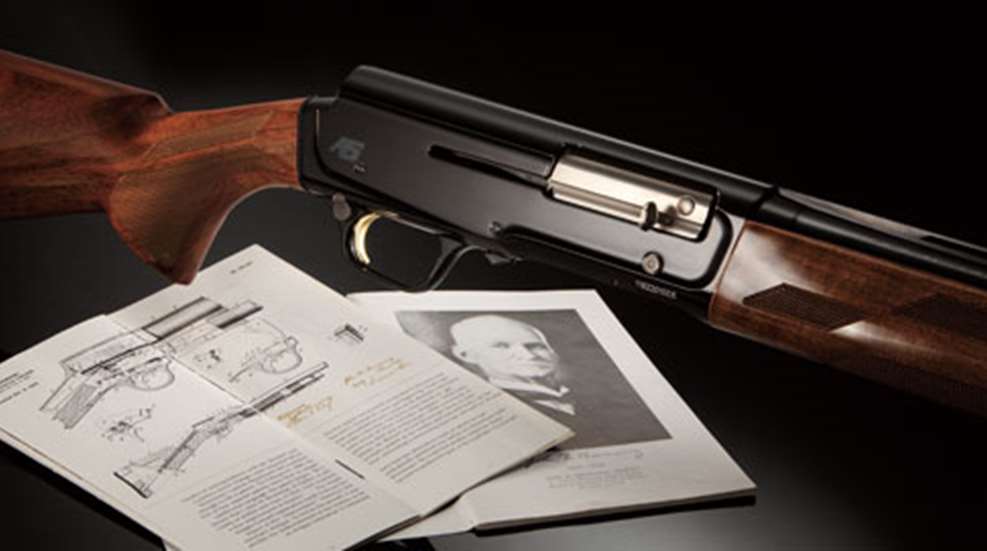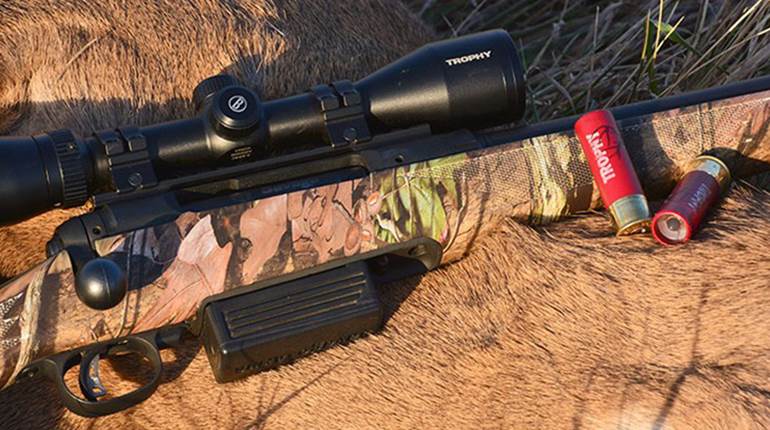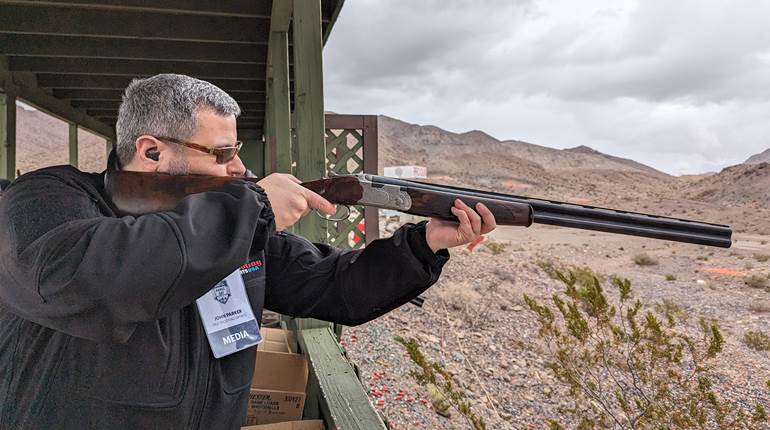
“I want one!” yelled guide Kelly Moore from the other end of the blind. It took Moore exactly one shot and one dead duck to arrive at that conclusion after I handed him Browning’s new semi-automatic. Dubbed the “A5” after the classic Auto-5, the new gun is sure to provoke many more such strong reactions from Browning fans everywhere. Some hardcore hunters like Moore, who grew up hunting with Auto-5s and shoots best looking down the eye-catching humpback receiver, will love seeing the familiar profile in an updated package. However, die-hard Auto-5 purists will insist that naming and styling any gun after John M. Browning’s original classic borders on sacrilege. Whether you are ready to love the new humpback, hate it, or want to wait and see, the A5 is still a semi-automatic from the company that invented semi-autos, and therefore it merits a closer look. In a nutshell, the A5 combines the inertia action made popular by Benelli with the square-backed receiver profile of the Auto-5.
Obviously, the humpback receiver is the first thing you notice on this gun. The original Auto-5 was humpbacked out of necessity. The receiver had to accommodate the bolt and barrel traveling backward together far enough to eject the empty shell and pick up a new one on the trip back to battery. Auto-5 shooters came to love the square receiver both because it caught their eye and because it functioned as an extra long rib. Whether a long sighting plane really is a benefit in shooting a shotgun is irrelevant. Generations of Auto-5 shooters believe it is and there is no arguing with them, nor with the gun’s record of success.
The new A5 borrows that same profile, although its receiver is made of aluminum alloy, not steel, and underneath the retro styling you will find Browning’s version of the inertia system. Browning calls the action “Kinematic Drive,” a name that sounds as if taken from a 1956 Buick owner’s manual. In Browning’s parlance, “Kinematic” is another name for “inertia,” but regardless of what you call it, both systems make use of a heavy, two-part bolt consisting of a rotary head and a heavy body with a short, stout spring in between. As the gun moves back under recoil, the bolt, which is at rest, dutifully obeys the laws of inertia and remains at rest. Initially, the rearward motion of the gun pushes against the rotary bolthead, causing it to turn and lock tightly into the breech. As the gun’s movement slows, the spring opens, throwing the entire two-part bolt rearward, unlocking the action and extracting the spent shell. A return spring in the stock pushes the bolt back to battery.
The advantage of inertia/Kinematic operation is that there is no need to bleed gases from the action to cycle the gun so it remains clean and keeps on working long after other guns may foul. And, while inertia guns don’t offer the recoil reduction of some gas guns, they are softer-shooting than fixed-breech designs. Unlike the Auto-5, which had friction rings that needed adjustment between “light” and “heavy” settings, the A5’s Kinematic Drive handles loads from the heaviest magnums down to 1-ounce, 1,180-fps target loads without adjustment. Benelli’s 1986 patent on its excellent, reliable inertia system expired in 2006, opening the door for Browning to develop the A5. The gun will be produced at Browning’s Viana plant in Portugal. “It’s no secret we are going after Benelli,” says Browning engineer Mark Lesenfants, but he goes on the point out there are differences between the two versions of the inertia system. Browning engineers drew on the company’s experience with the rotary bolt design of the BAR center-fire rifle as they designed the A5. For instance, the bolt features four locking lugs as seen on the BAR as opposed to Benelli’s two lugs. In place of a barrel extension as seen on Benellis (on the Super Black Eagle the entire top half of the receiver is the extension) it has a steel reinforcing bar along the inside top of the receiver. Lesenfants says the gun cycles even faster than a Benelli. “I can outrace a Benelli with my trigger finger but not this gun,” he says. Cycling time is one of those statistics that do not make much difference in real-world hunting and shooting, but the speed of the Kinematic Drive does speak to the design’s slick functionality.
The gun shows its Browning lineage in ways besides its distinctive profile, sharing several features with Browning semi-automatics past and present. Speed loading is a Browning hallmark that originated with the Auto-5. The speed load feature results from the gun’s two-piece carrier. When the bolt locks open after the last shell is fired, the carrier design allows you to reload by thumbing a shell into the magazine tube and having it whisk into the chamber with the bolt slamming shut behind it.
Like the Maxus, the A5 has the “TurnKey” magazine plug, a feature that lets you turn and remove the duck plug with a house or car key. And, it does so in such a way that there’s no danger of shooting a magazine spring across the room or into the weeds in the field. The A5 has a roomy trigger guard very similar to that of the Maxus, and it has a big, easy-to-use safety button located at the rear of the trigger guard. The safety can be reversed from right- to left-hand operation in about two minutes. The A5 also has the Inflex II recoil pad found on the Maxus, a very soft pad with baffles that direct the recoiling gun down and away from the shooter’s face.
One Browning feature apparently missing from the A5 is the magazine cutoff lever. The Auto-5 and other Brownings have a lever you can flip, allowing you to remove the round in the magazine without chambering the next one. However, the A5, like a Benelli, has a carrier stop button that must be engaged to make the bolt stand open. Therefore if you want to remove the shell in the chamber, you pull back the bolt, remove the round in the chamber, and it will close without cycling the next round. It’s a feature that comes in very handy when you want to safely cross an obstacle, or when you want to pull out a duck load and drop in a goose shell. Incidentally, the carrier stop button on the A5 is large, easy to use and easy to find in front of the trigger guard even with gloves on.
While the original Auto-5 had a great deal of drop to its stock, the A5 has dimensions more familiar to shooters of the Gold and Maxus: 1 3/4 inches of drop at the comb and 2 inches at the heel. In addition, the A5 comes with shims allowing adjustment of the stock for drop and cast, as well as spacers enabling the shooter to lengthen it from 14¼ inches all the way out to 15 inches. The A5 also has the 0.742-inch overbored barrel common to modern Browning 12 gauges as well as the Vector Pro lengthened forcing cone. It comes with Browning’s newest Invector choke tube system, the Invector DS (“double seal”) which has threads at the top, and a brass ring at the bottom that seals the bottom of the tube, preventing dirt and residue from building up between the tube and the barrel.
The first A5s will be available in 3-inch, 12 gauge, in all-black, blued/walnut and camouflage finishes. I would have preferred the classic round knob pistol grip and more conventional checkering on the wood model, but it is a handsome shotgun nevertheless with typically rich Browning bluing and glossy walnut. The black and camo guns appear to be tailor-made for abuse in the marsh. The gun sells for $1,399 in black, $1,559 in wood.
I had the chance to hunt and shoot clays with the A5 both in South Dakota at a Browning-sponsored introductory pheasant hunt and at home on my own. It’s light (my synthetic stocked, 26-inch barreled test gun weighed just under 7 pounds) and it carried easily up and down the long strips of corn and milo in South Dakota. Recoil wasn’t bad. Between the inertia action and the soft pad, I shot many 13⁄8-ounce, 1,300-fps pheasant loads and 1¼-ounce 1,450-fps duck loads without complaint. The gun pointed naturally, and I found it very easy to hit with.
For those Browning fans who have always been torn between brand loyalty and the inertia action’s advantages of reliable, low-maintenance operation, this gun is the answer.
That’s my opinion, but what would John Browning himself thought of the gun named after his most famous shotgun? Browning would have been aware of inertia guns, as the Danish-made Sjorgren Normal used an ungainly version of the system back in 1909. Without doubt the great gun designer would have appreciated the elegant simplicity of the A5’s mechanism. He also would have noticed that the inertia system also allows a gun to be light and trim, especially in the forearm that has only to fit over the magazine tube and can thus be slimmer than a gas gun’s forearm and as slim as an over-under’s. The result is a gun that sits low in your front hand and points naturally. It’s the A5’s light weight, balance and pointability that makes me think John M. would have approved.
Manufacturer: Browning Viana, Portugal
Importer: Browning; (801) 876-2711; www.browning.com
Mechanism Type: inertia-operated, semi-automatic shotgun
Gauge: 12, 3"
Receiver: black anodized aluminum alloy
Overall Length: 495⁄8" (28" barrel)
Barrel Length: 26" (tested), 28", 30"
Weight: 6 lbs., 14 ozs.
Magazine Capacity: TurnKey plug, four
Trigger Pull: single-stage, 5 lbs., 13 ozs.
Stock: high-gloss walnut: length of pull, 141⁄4"; drop at comb, 13⁄4";drop at heel, 2"
Chokes: interchangeable Invector DS choke: improved cylinder, modified and full
Sights: white mid-rib bead, brass front bead
Accessories: three choke tubes, choke tube wrench, two spacers, extended stock screws, cable lock, instruction manual, ABS plastic case.
Suggested Retail Price: $1,559 (Hunter); $1,399 (Dura-Touch Stalker); $1,559 (Dura-Touch Mossy Oak Duck Blind or Break-Up Infinity)





































